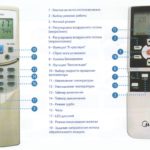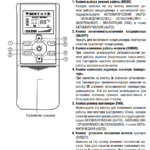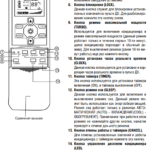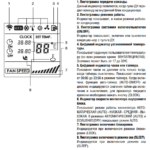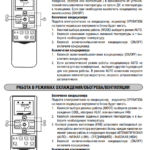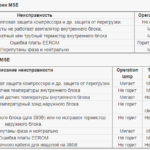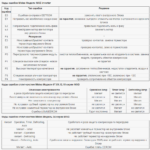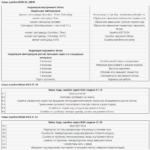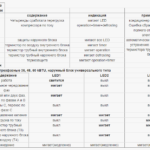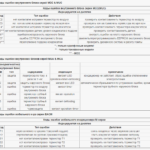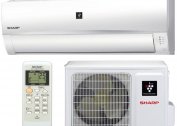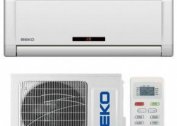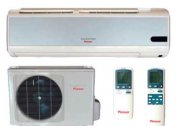The famous manufacturer Midea began its history in 1968 as a small workshop that performed the production of plastic parts. The founder of the existing corporation was He Xiangjiang, who is still considered the honorary director of the concern. If earlier air conditioning equipment was used only in offices, today there is a huge amount of universal climate equipment that can be easily and simply mounted in small apartments and private houses.
This equipment specifically refers to the Midea wall-mounted split system, the description of which is disclosed in this information article.
Main lineup and distinctive features
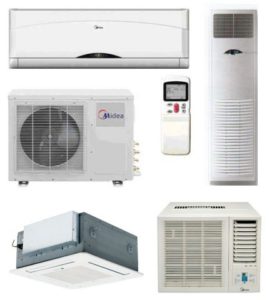 Since the company, at the facilities of which Air Conditioners have been manufactured for several decades, Midea has been leading in the markets of the CIS countries, this has significantly increased its range, among which you can find budget options for an apartment (for example, MSMA-07HRN1-Q ION), portable all-in-ones for office (MPPD-09CRN1) or channel devices for industrial needs (model MTB-60HRFN1).
Since the company, at the facilities of which Air Conditioners have been manufactured for several decades, Midea has been leading in the markets of the CIS countries, this has significantly increased its range, among which you can find budget options for an apartment (for example, MSMA-07HRN1-Q ION), portable all-in-ones for office (MPPD-09CRN1) or channel devices for industrial needs (model MTB-60HRFN1).
Midea produces the following types of climate equipment:
- Wall split systems (MS12F-09HRN1, MSMA-12HRN1-Q, MSMA-18HRN1-Q).
- Mobile air conditioning (MPPD-12ERN1, MPN2-12ERN1, MPPD-09ERN1).
- Window monoblocks (MWF-07CR, MWF-18CR, MWF-09CR).
- Column or cabinet air conditioners (MFGA-48ARDN1, MFM-60ARN1, MFGA-60ARDN1).
- Floor (ceiling) complex (MUE-60HRFN1, MUB-60HRN1, MUB-24HRN1).
- Channel multisplit systems for industry (MHB-96HRN1 / MOV-96HN1-C, MHG-60HDRN, MHG-60HRN1).
- Cassette split systems (MCD-48HRFN1, MCA-18HR, MCD-36HRDN1).
- Multizone split systems (MDV Digital Scroll, MDV DC invertor).
Wall mounted air conditioning systems
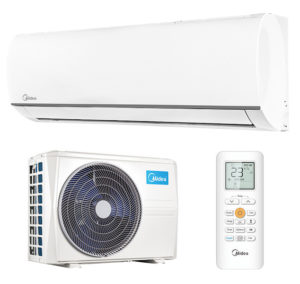 Wall-mounted air conditioner Midea is often used for domestic needs (in the nursery, living room, kitchen, etc.). They are easy to operate, reliable in operation, easy to install and differ in an affordable price category. It is also worth noting that, thanks to the wide range of models that the Midea brand is represented in, it is possible to choose a device not only for an apartment or a domestic building, but also for an average office or a cottage. Air conditioners of this class can be turned on for heating, in ventilation mode or for air conditioning.
Wall-mounted air conditioner Midea is often used for domestic needs (in the nursery, living room, kitchen, etc.). They are easy to operate, reliable in operation, easy to install and differ in an affordable price category. It is also worth noting that, thanks to the wide range of models that the Midea brand is represented in, it is possible to choose a device not only for an apartment or a domestic building, but also for an average office or a cottage. Air conditioners of this class can be turned on for heating, in ventilation mode or for air conditioning.
Midea wall-mounted air conditioners have achieved such success due to the following differences from competitors:
- Inverter air conditioners developed on the Midea Global platform (Mission DC series) meet the high requirements of efficiency (A ++) and in their basic configuration contain a Wi-Fi module.
- The indoor unit is characterized by an ergonomic appearance in the style of "minimalism".
- The presence of the "Early Start" function, thanks to which, when the device is scheduled to be started using the timer, all systems will be started in advance to prepare the air conditioner for a smooth start.
- High power thanks to which it is possible to heat or cool the area to 110 m without problems2 (MSG-36HR).
Among the variety of such systems, we pay special attention to the 3 most common models of wall-mounted split systems from Midea.
Comparison of the characteristics of popular models
| Name of equipment | MSMB-09HRN1 ION | MSMA-12HRN1-Q ION | MSMB-18HRFN1-Q / HB |
| Maximum working area, m2 | 25 | 35 | 50 |
| Air ionization function | + | + | – |
| System performance in heat / cold modes, kW | 2,78/2,6 | 3,81/3,52 | 6,8/6,18 |
| type of drive | Standard | Standard | Inverter |
| Additional features | Eco mode | Super Cool 17C | Eco mode |
| The minimum allowable temperature 0WITH | -7 | -7 | -20 |
| Fine filters | + | + | + |
| Maximum noise level at full system load, dB | 37 | 42 | 42 |
According to the above table, the wall-mounted models of Medea climatic equipment differ not only in the area for heating or conditioning, but also in the presence of additional functions and the ability to work at extreme temperatures.
Window air conditioners Midea
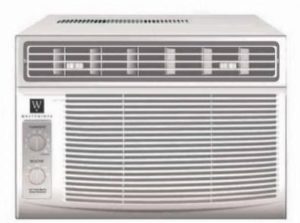 The portable window air conditioner is mounted in office rooms, which for some reason do not need (temporary or rented premises) or the possibility (it is impossible to disturb the supporting structures) in the installation of stationary wall-mounted devices with an outdoor unit.
The portable window air conditioner is mounted in office rooms, which for some reason do not need (temporary or rented premises) or the possibility (it is impossible to disturb the supporting structures) in the installation of stationary wall-mounted devices with an outdoor unit.
According to their characteristics, they are in no way inferior to wall-mounted equipment, the only difference is the installation method.
The most popular series of this equipment is the Midea “MWF”. These air conditioners differ in the following characteristics:
- The design of the device contains easily removable grilles, due to which access to the coarse filter is facilitated.
- All air conditioners are equipped with a "Sliding Chassis" due to which the device is easy to get from a niche for maintenance.
- Window type air conditioners operate either for air recirculation or deliver fresh air from the outside.
- Able to work only in the "Cooling" mode.
Cassette multi-split VRF (VRV) systems
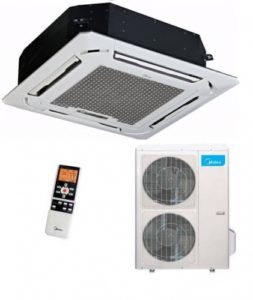 Such systems are mounted permanently in medium and large facilities (offices, trading floors, exhibition centers, small production facilities, etc.).
Such systems are mounted permanently in medium and large facilities (offices, trading floors, exhibition centers, small production facilities, etc.).
Midea cassette air conditioning allows you to effectively control the microclimate, due to the creation of a multi split system. Thanks to this function, up to 6 indoor devices can be connected to one outdoor unit.
According to manufacturer Midea, this type of semi-industrial and industrial equipment is divided into:
- Cassette (MCA, MCD).
- Inverter cassette type (MCA3, MCD Invertor).
Distinctive features
- Effective work in rooms with high ceilings (up to 6m).
- Mounting the device in a suspended ceiling, or Armstrong type ceiling. "
- The use of 180 ° technology for inverter conversion, which prevents the formation of power surges.
- The presence of a panel with an "elevator mechanism" (MBQ-02D5). This technology allows you to lower the grill by 4 meters to replace or clean the filter.
- 360 air distribution0.
Instructions for the control panel and air conditioners Midea
To control the parameters of the system, you need a remote for the Midea air conditioner. It allows you to:
- Fully set up automatic operation of the equipment.
- Set the direction of air flow.
- Turn on "Night mode".
- Set the required room temperature.
- Perform self-cleaning and self-diagnosis of the air conditioner.
In order to fully understand the functionality of controlling the system, the manufacturer has developed a manual for air conditioners Midea (instruction manual). It can be found in the basic supply of air conditioning equipment.
Error codes for air conditioners Midea
This section presents the main errors and their decoding, which will be displayed on the indoor unit of the air conditioner when it is detected by the device’s self-diagnosis system. The malfunction information is contained in the device passport.
User reviews
In most cases, reviews about the products of the company Midea are positive, but for some reason they have a negative connotation. Systematic user reviews can be found below.
Positive reviews
- Affordable prices (cost) and excellent quality (out of 3000 installed air conditioners, not a single failure).
- Warranty on all air conditioner lines.
- Inverter circuits provide fast cooling and low power consumption.
- A multi-split system of several wall-mounted air conditioners allows you to control the microclimate in large rooms.
- It is easy to find remove and buy spare parts (inverter).
- Repairing and cleaning the Midea air conditioner is easy and simple, since a service center can be found in both large and small cities.
- Midea air conditioners have a powerful Toshiba variable-speed compressor, which is set at the factory.
- Work at very low temperatures to -150C (the air conditioner MSMB-18HRFN1-Q / HB was installed).
- A wide range of products (see the chapter "Main model line").
- Mobility (portable air conditioners). These devices are easy to clean with your own hands without disassembling the indoor unit.
- Installing a window-type Midea air conditioner takes only 30-40 minutes, and its settings are easy to do on your own.
Negative reviews
- The increased noise in the maximum operating mode (ceiling conditioners).
- Difficulties in the selection and replacement of the drainage tube with your own hands.
- Complex setup, since the ducted air conditioner has a complex structure.
- The receiver on the unit did not respond to a signal from the remote control. It turned out that it was just necessary to replace the batteries.
